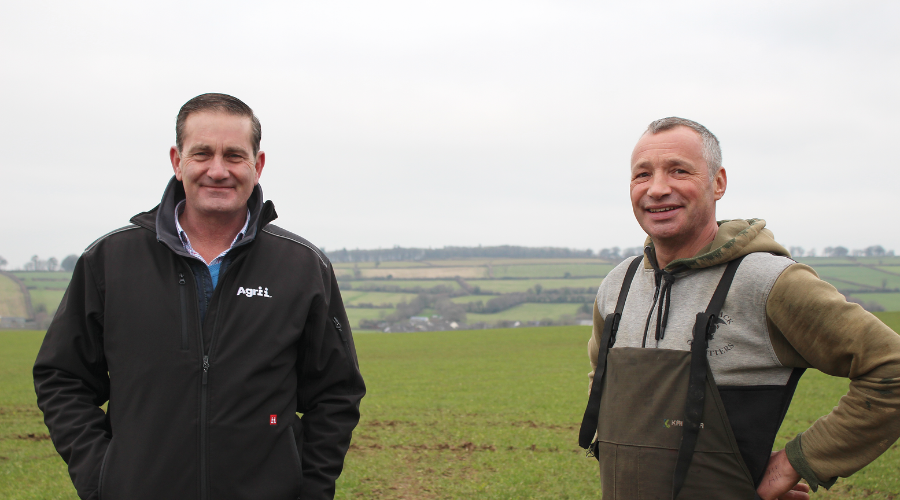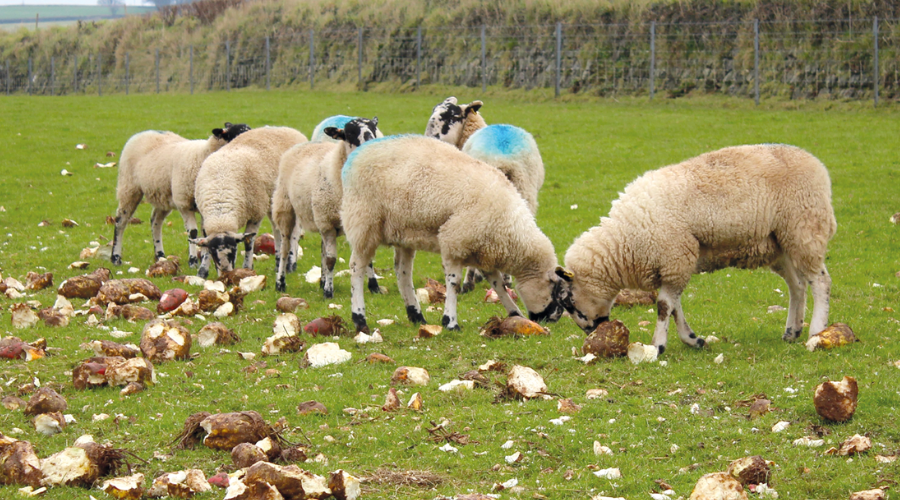Fodder beet keeps sheep on a roll
3rd April 2025
Robert Tucker, from Beera Farm near Tavistock, describes fodder beet as a staple in his armoury of home-grown forages. He has grown 4–6ha of the crop each year since 2019, and before that bought in supplies.

“It’s a high energy forage that’s ideal for our ewes pre- and post-lambing,” he says. “We feed in situ or lifted, and feed out to sheep on grassland. It depends on the conditions.”
Robert is fortunate in having local contractors available to lift the fodder beet, which takes place every three to four weeks. “I use an old muck spreader to chop the beet a bit and spread it across the grassland – a four-tonne load will keep a group of 200 ewes going for a week.
“They love it, and by spreading the beet down the field we don’t get muddy conditions around a feed trough – and resulting foot issues. It’s a system that works well here.”
Flexible harvest
The rest of the harvest is stored in an open clamp, near the grassland, ready for feeding.
“It’s another reason why I like fodder beet,” he says. “Harvesting time is flexible, and it stores well in the ground or in a clamp. There are plenty of options with lifting and feeding, so it can fit around conditions and requirements without affecting yield or feed value.”
As well as providing high feed value from December and through winter, when grass growth is minimal, this fodder beet crop fits well into the 130ha farm’s forage rotation.
Drilling takes place from late April, and follows grass, which is ploughed and a fine seed bed prepared. A heavy application of farmyard manure is ploughed in and a 20:10:10 compound fertiliser is applied at a rate of 370kg/ha into the seedbed. As a safeguard, 2.5t/ha of lime is applied to ensure a pH of 6.5.
Working with his Agrii agronomist Oliver Cradick, Robert opts for a treated seed to maximise germination. He also recommends 2–3 post emergence fungicide treatments depending on conditions.
“It’s important to make sure pests and weeds are under control early on,” says Oliver. “It helps get the crop off to a good start. And once its germinated it will then flourish.”

Consistent variety
Robert is particular about the variety grown – the medium loam soil is perfect for fodder beet, but it’s stoney so they avoid deep-rooted varieties, instead seeking one that is clean, with consistent yields and high feed value.
His variety of choice, which has been grown at Beera farm for the past two years, is Limagrain’s Robbos. He’s bought the seed for drilling the 2025/26 crop.
This medium-rooted yellow beet has been trialled by Limagrain for 25 years with results showing consistent dry matter yields of more than 18t/ha.
The average metabolisable energy content for fodder beet varieties trialled annually by Limagrain is consistently 12.5–13 MJ/kg DM, with Robbos typically exceeding this.
As a forage crop, fodder beet is quite expensive to grow. “But it’s reliable and it meets the ewes’ requirements when other forages are limited. Otherwise, we’d have to move sheep to other grazing off the farm, or buy in feed, and this would be more costly and time-consuming.”
Ewes lamb indoors and move on to haylage and concentrates. The first group start lambing in mid-January, ending with ewe lambs in April.
Early lambs are housed and are turned out once conditions are good enough. They too will get some fodder beet to supplement their diets.
System works well
While Robert manages the farm mainly single-handed through the year, he has two vet students, and a regular lambing assistant throughout peak lambing.
A heavy reliance is placed on home grown forages, with the mainstay being grass, made up of 50ha of permanent pasture and 70ha of short-term leys currently being drilled to herbal leys under the SFI scheme.
These leys form part of the rotation with fodder beet and forage rape and, in summer, the hybrid brassica, Skyfall, which provides 2–3 rounds of grazing from July onwards.
Robert looks to finish the first crop of lambs from May onwards with most finished by September. These are mostly sold through Waitrose’s West Country Lamb scheme.
He sells around 2,000 lambs a year and buys in 250–300 replacement-ewe lambs from Hawes sheep sales every September.
“We’ve developed a system that works well,” adds Robert. “We aim to be self-sufficient in forage requirements, and it can be a challenge, but having a forage like fodder beet that can ‘go with the flow’ a bit when it comes to flexibility and storage is an advantage.”
Read more livestock news.



